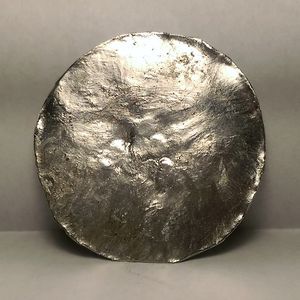Indium
 Disc of indium | |||||
| General properties | |||||
|---|---|---|---|---|---|
| Name, symbol | Indium, In | ||||
| Appearance | silvery lustrous gray | ||||
| Indium in the periodic table | |||||
| |||||
| Atomic number | 49 | ||||
| Standard atomic weight (Ar) | 114.818(1) | ||||
| Group, block | , p-block | ||||
| Period | period 5 | ||||
| Electron configuration | [Kr] 4d10 5s2 5p1 | ||||
per shell | 2, 8, 18, 18, 3 | ||||
| Physical properties | |||||
| Silvery-gray | |||||
| Phase | Solid | ||||
| Melting point | 429.7485 K (156.5985 °C, 313.8773 °F) | ||||
| Boiling point | 2345 K (2072 °C, 3762 °F) | ||||
| Density near r.t. | 7.31 g/cm3 | ||||
| when liquid, at | 7.02 g/cm3 | ||||
| Triple point | 429.7445 K, ~1 kPa | ||||
| Heat of fusion | 3.281 kJ/mol | ||||
| Heat of | 231.8 kJ/mol | ||||
| Molar heat capacity | 26.74 J/(mol·K) | ||||
| pressure | |||||
| Atomic properties | |||||
| Oxidation states | 3, 2, 1, −1, −2, −5 (an amphoteric oxide) | ||||
| Electronegativity | Pauling scale: 1.78 | ||||
| energies |
1st: 558.3 kJ/mol 2nd: 1820.7 kJ/mol 3rd: 2704 kJ/mol | ||||
| Atomic radius | empirical: 167 pm | ||||
| Covalent radius | 142±5 pm | ||||
| Van der Waals radius | 193 pm | ||||
| Miscellanea | |||||
| Crystal structure | tetragonal | ||||
| Speed of sound thin rod | 1215 m/s (at 20 °C) | ||||
| Thermal expansion | 32.1 µm/(m·K) (at 25 °C) | ||||
| Thermal conductivity | 81.8 W/(m·K) | ||||
| Thermal diffusivity | 83.7 mm2/s (at 300 K) | ||||
| Magnetic ordering | Diamagnetic | ||||
| Young's modulus | 11 GPa | ||||
| Mohs hardness | 1.2 | ||||
| Brinell hardness | 8.8–10.0 MPa | ||||
| CAS Registry Number | 7440-74-6 | ||||
| History | |||||
| Discovery | Ferdinand Reich and Hieronymous Theodor Richter (1863) | ||||
| First isolation | Hieronymous Theodor Richter (1867) | ||||
Indium is a chemical element with symbol In and atomic number 49. A post-transition metal, indium is used mostly in electronics, for indium tin oxide transparent conductive coatings.
Contents
Properties
Chemical
Indicium is fairly resistant to corrosion and the effects of many chemicals. It does not react with elements such as boron, silicon or carbon when heated together, however it will react with halogens or oxalic acid to give their respective salts.
Indium burns in the presence of oxygen with a blue flame at high temperatures to form indium(III) oxide:
- 4 In + 3 O2 → 2 In2O3
Indium also forms indium(I) compounds, though they are not as characterized as indium(III) ones. The most well known are indium(I) oxide, which is a black compound and indium(I) sulfide. Both are made at high temperatures and have little applications. Indium(I) halides cyclopentadienyl compounds are also known.
Indium also displays an intermediate oxidation state +2, though only the halides are known and important.
Physical
Indium is a very soft, silvery-grey, highly ductile, relatively rare post-transition metal with a bright luster. Indium is soft enough to be cut with a knife and is soft enough to leave a visible line on paper. Like tin, indium emits a high-pitched "cry" when it is bent. Indium is able to wet glass when melted, property also observed in gallium. Indium has a low melting point, of 156.60 °C and boils at 2072 °C. Its density at room temperature is 7.31 g/cm3.
Availability
Indium is sold by various chemical suppliers, though it's pricey.
Onyxmet sells indium metal, and it's around 99.995% pure. 100 g costs around 67.50 €.
Laboratoriumdiscounter sells indium in the form of granules, foil and wire.
Chemcraft sells a large variety of indium and its compounds.
Metallium sells small samples of indium metal.
Rotometals sells indium in the form of ingot, shot and even powder.
Indium metal can also be found on eBay and Amazon.
Certain solders contain small amounts of indium, though extracting it may not be practical.
Isolation
Indium can be extracted from solders or transparent coatings by dissolving them in acid and then obtained from its salts via either reduction with zinc metal or electrowinning. However, the amount obtained this way is small.
Projects
- Demonstration of metal "cry"
- Low melting point alloys
Handling
Safety
Indium does not have any metabolic role in any organism. Due to its position in group 13, its chemical properties are similar to that of aluminium compounds. Indium(III) ions have shown to have a toxic effect on the kidneys when given by injection, however, when taken orally, indium compounds do not have the chronic toxicity of salts of heavy metals, due to poor absorption in basic conditions.
Storage
Indium should be stored in closed containers. As it tends to wet glass, it's best to keep it in plastic containers.
Disposal
Due to its high price, it's best to try to recycle indium, rather than just throw it away.